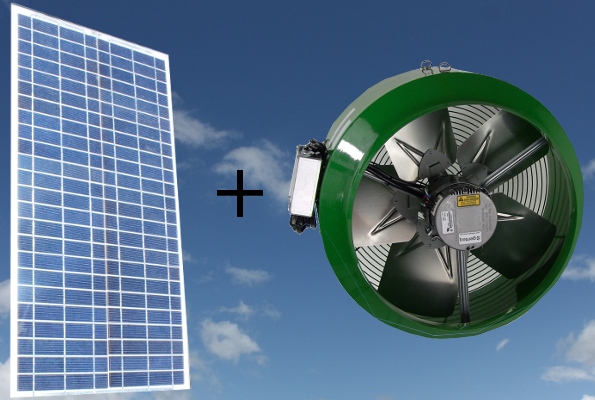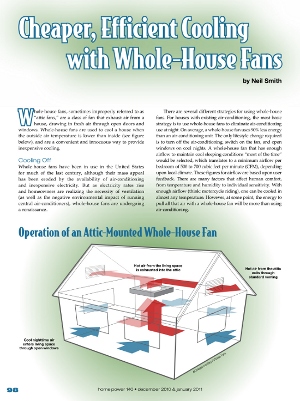Whole House Fan Applications
Kohilo* Returns Home
 With a warm climate year round and relatively cool nights thanks to the ocean breeze, the state of Hawaii is a perfect place for AirScape Whole House Fans. Not only is the weather ideal, but the cost of electricity is sky high. The average cost for electricity in August 2010 in Hawaii was 28.59 cents per kilowatt hour. Compared to the U.S. Average of 12.02 cents during the same month**, it is obvious that going green by lowering electrical use is not as much a choice as it is a financial necessity for many residents of Hawaii.
With a warm climate year round and relatively cool nights thanks to the ocean breeze, the state of Hawaii is a perfect place for AirScape Whole House Fans. Not only is the weather ideal, but the cost of electricity is sky high. The average cost for electricity in August 2010 in Hawaii was 28.59 cents per kilowatt hour. Compared to the U.S. Average of 12.02 cents during the same month**, it is obvious that going green by lowering electrical use is not as much a choice as it is a financial necessity for many residents of Hawaii.
Armstrong Builders has partnered with the DHHL (Department of Hawaiian Home Lands) to build affordable green homes in a state where affordable housing is virtually unheard of and utility rates are astronomical. The communities “Kumuhau” and “Lai Opua Village” both include AirScape Kohilo-e Whole House Fans (the Kohilo-e is a special limited edition model using the highly efficient ECM technology designed specifically for Armstrong Builders for use in their projects). Even with the high electrical rate, the fan only costs an average of 5.7 cents an hour on high speed and 1.4 cents an hour on low speed. Compare that to an extremely efficient 2 ton Air Conditioner, which is going to cost 68.5 cents an hour on average, and it’s easy to see why our whole house fans are so beneficial in Hawaii.
As Kaulana H.R. Park, director of DHHL and chairman of the Hawaiian Homes Commission (HHC) said, “Reducing living costs is one measure of a sustainable lifestyle and as native Hawaiians, living a sustainable life is what we strive for.”***
We’re glad we can be a part of this move towards greater sustainability in Hawaii.
*Kohilo is Hawaiian for “a gentle breeze”
**For average electrical rates by state, visit the Energy Administration Website.
Affordable and Sustainable
Homewise in Santa Fe, New Mexico helps moderate homeowners achieve affordable home ownership. That’s great! We appreciate the fact that Homewise understands that sustainable and affordable are part of good design and planning. They have chosen to use one of our whole house fans in every house.

is the recession over
Being an engineer, and full of opinions, people often ask me when this recession will end. Good question. In fact, a friend of mine just asked me that. Luckily for him, we were bicycling uphill, and I could not devote my remaining breath to verbalizing the solution.
Well, after a bit of thinking I realized that maybe, just maybe I have a metric, or at least an indicator for when our economy starts to grow.
It comes down to this. When institutions and organizations return to increasing productivity, then we are on the road to increasing wealth. Why should this simple metric be more important than an economist who knows way more math than most of us? Well, I’m going to bring in some handy engineering tools:
- The Control Volume. This is a great concept because it’s so simple and elegant. Draw an imaginary surface around whatever you are studying. Now, the increase in whatever you are measuring has to come from either greater input or less output. A corollary of this is “garbage in, garbage out”.
- Some basic calculus. All you need to know is rate of change.
- BS detector. (based upon proprietary common sense algorithm)
Let’s go over some social institutions and I’ll grade them. The grade up/down is based on whether I (using my tools above) judge whether the institution is providing more benefit to society than the year before.
So, there’s the theory. When these groups/industries/institutions stop feeding and start producing, then we create wealth again. And in case there are any misconceptions, here is what wealth really means to us:
- Jobs
- Clean environment
- Public Safety
- Education
- Retirement
- and last… Stuff.
Solar Loves Whole House Fans
There are a couple of trends that will affect solar photovoltaic installations:
- Newer electrical rate structures encourage conservation (tiered rates)
- ‘Energy Security’ is a powerful motivator
- Photovoltaic rebates require house efficiency check-ups
 We think solar energy gathering is great. The idea of getting electricity essentially for free energy has certainly captivated our imaginations. Even though the cost of photovoltaic panels is dropping very quickly, the investment is still considerable. Our crystal ball tells us that electrical energy is very, very versatile and will be in demand as electrical cars come on stream and coal fired electrical power plants start to show their ugly side. (coal burning)
We think solar energy gathering is great. The idea of getting electricity essentially for free energy has certainly captivated our imaginations. Even though the cost of photovoltaic panels is dropping very quickly, the investment is still considerable. Our crystal ball tells us that electrical energy is very, very versatile and will be in demand as electrical cars come on stream and coal fired electrical power plants start to show their ugly side. (coal burning)
As the demand for clean electrical energy increases, its value will certainly not go down. In fact, if the validity of predicting cheap energy such as the famous line is any guide “too cheap to meter”,then we should get prepared for high prices.
By combining whole house fans solar contractors and homeowners can:
- Decrease the initial investment in PV panels
- AND/ OR
- Increase the Return on Investment for the entire system
sustainable budhism
 The local buddhist temple has just been completed. AirScape provided several whole house fans. The building itself is constructed with ICF (insulated concrete forms). This makes for a high mass, well insulated and sealed building envelope, perfect for whole house fans. Total airflow from the whole house fans is 9200 CFM – the building is 6,000 sq. feet. That’s a good lot of air, but this is the only form of cooling, so the amount of airflow has to be high for the peak conditions.
The local buddhist temple has just been completed. AirScape provided several whole house fans. The building itself is constructed with ICF (insulated concrete forms). This makes for a high mass, well insulated and sealed building envelope, perfect for whole house fans. Total airflow from the whole house fans is 9200 CFM – the building is 6,000 sq. feet. That’s a good lot of air, but this is the only form of cooling, so the amount of airflow has to be high for the peak conditions.
If you want to design your own temple, Carlos Delgado is the architect.





